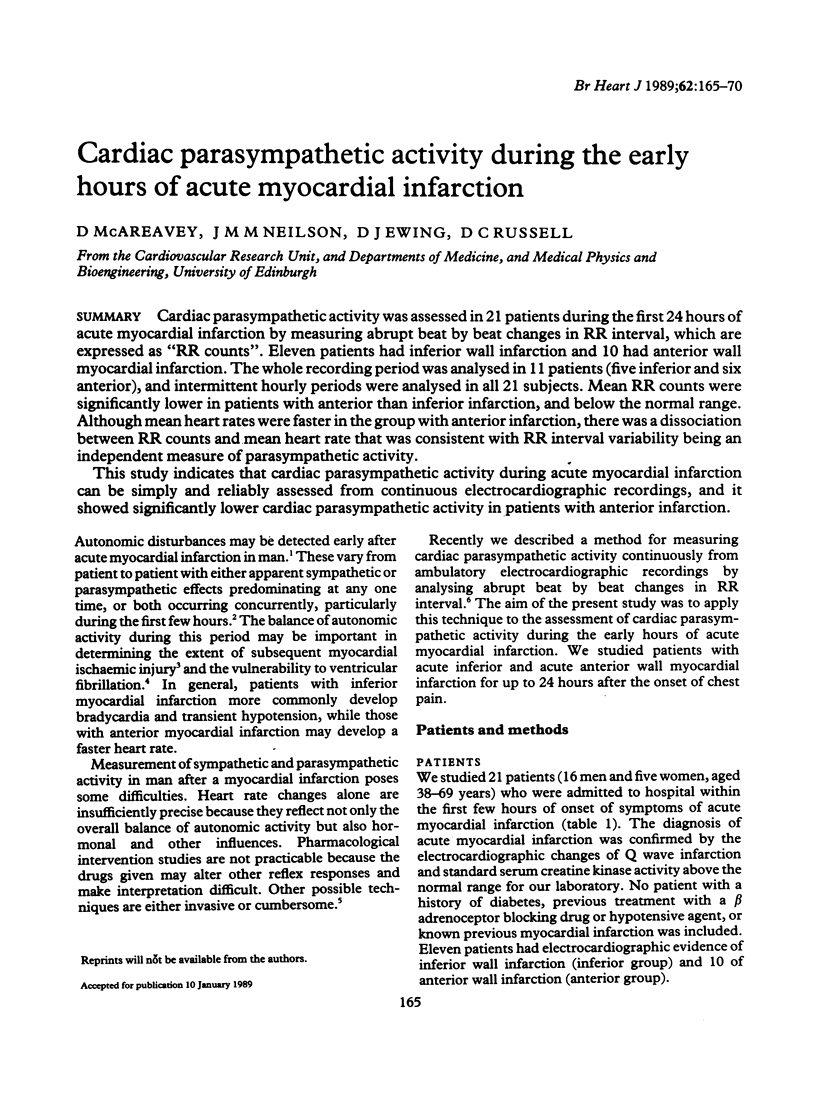Abstract
Cardiac parasympathetic activity was assessed in 21 patients during the first 24 hours of acute myocardial infarction by measuring abrupt beat by beat changes in RR interval, which are expressed as "RR counts". Eleven patients had inferior wall infarction and 10 had anterior wall myocardial infarction. The whole recording period was analysed in 11 patients (five inferior and six anterior), and intermittent hourly periods were analysed in all 21 subjects. Mean RR counts were significantly lower in patients with anterior than inferior infarction, and below the normal range. Although mean heart rates were faster in the group with anterior infarction, there was a dissociation between RR counts and mean heart rate that was consistent with RR interval variability being an independent measure of parasympathetic activity. This study indicates that cardiac parasympathetic activity during acute myocardial infarction can be simply and reliably assessed from continuous electrocardiographic recordings, and it showed significantly lower cardiac parasympathetic activity in patients with anterior infarction.
Full text
PDF





Selected References
These references are in PubMed. This may not be the complete list of references from this article.
- Bellavere F., Ewing D. J. Autonomic control of the immediate heart rate response to lying down. Clin Sci (Lond) 1982 Jan;62(1):57–64. doi: 10.1042/cs0620057. [DOI] [PubMed] [Google Scholar]
- Eckberg D. L. Human sinus arrhythmia as an index of vagal cardiac outflow. J Appl Physiol Respir Environ Exerc Physiol. 1983 Apr;54(4):961–966. doi: 10.1152/jappl.1983.54.4.961. [DOI] [PubMed] [Google Scholar]
- Ewing D. J., Hume L., Campbell I. W., Murray A., Neilson J. M., Clarke B. F. Autonomic mechanisms in the initial heart rate response to standing. J Appl Physiol Respir Environ Exerc Physiol. 1980 Nov;49(5):809–814. doi: 10.1152/jappl.1980.49.5.809. [DOI] [PubMed] [Google Scholar]
- Ewing D. J., Neilson J. M., Travis P. New method for assessing cardiac parasympathetic activity using 24 hour electrocardiograms. Br Heart J. 1984 Oct;52(4):396–402. doi: 10.1136/hrt.52.4.396. [DOI] [PMC free article] [PubMed] [Google Scholar]
- Fagraeus L., Linnarsson D. Autonomic origin of heart rate fluctuations at the onset of muscular exercise. J Appl Physiol. 1976 May;40(5):679–682. doi: 10.1152/jappl.1976.40.5.679. [DOI] [PubMed] [Google Scholar]
- Felder R. B., Thames M. D. Interaction between cardiac receptors and sinoaortic baroreceptors in the control of efferent cardiac sympathetic nerve activity during myocardial ischemia in dogs. Circ Res. 1979 Dec;45(6):728–736. doi: 10.1161/01.res.45.6.728. [DOI] [PubMed] [Google Scholar]
- Katona P. G., Jih F. Respiratory sinus arrhythmia: noninvasive measure of parasympathetic cardiac control. J Appl Physiol. 1975 Nov;39(5):801–805. doi: 10.1152/jappl.1975.39.5.801. [DOI] [PubMed] [Google Scholar]
- Lombardi F., Verrier R. L., Lown B. Relationship between sympathetic neural activity, coronary dynamics, and vulnerability to ventricular fibrillation during myocardial ischemia and reperfusion. Am Heart J. 1983 Jun;105(6):958–965. doi: 10.1016/0002-8703(83)90397-6. [DOI] [PubMed] [Google Scholar]
- Mark A. L. The Bezold-Jarisch reflex revisited: clinical implications of inhibitory reflexes originating in the heart. J Am Coll Cardiol. 1983 Jan;1(1):90–102. doi: 10.1016/s0735-1097(83)80014-x. [DOI] [PubMed] [Google Scholar]
- Potter E. K., McCloskey D. I., Courtice G. P. Enhancement of cardiac vagal action during ischaemia of the sino-atrial node. Clin Sci (Lond) 1986 Oct;71(4):449–451. doi: 10.1042/cs0710449. [DOI] [PubMed] [Google Scholar]
- Samaan A. The antagonistic cardiac nerves and heart rate. J Physiol. 1935 Feb 9;83(3):332–340. doi: 10.1113/jphysiol.1935.sp003232. [DOI] [PMC free article] [PubMed] [Google Scholar]
- Thames M. D., Klopfenstein H. S., Abboud F. M., Mark A. L., Walker J. L. Preferential distribution of inhibitory cardiac receptors with vagal afferents to the inferoposterior wall of the left ventricle activated during coronary occlusion in the dog. Circ Res. 1978 Oct;43(4):512–519. doi: 10.1161/01.res.43.4.512. [DOI] [PubMed] [Google Scholar]


